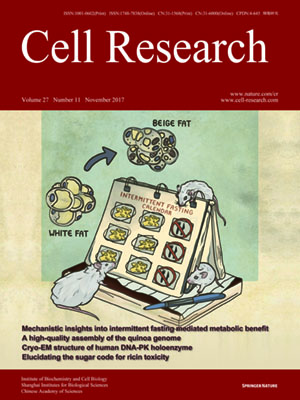
Volume 27, No 11, Nov 2017
ISSN: 1001-0602
EISSN: 1748-7838 2018
impact factor 17.848*
(Clarivate Analytics, 2019)
Volume 27 Issue 11, November 2017: 1392-1396
LETTERS TO THE EDITOR
An essential role for PNLDC1 in piRNA 3′ end trimming and male fertility in mice
Yue Zhang1,*, Rui Guo1,*, Yiqiang Cui1,*, Zhiping Zhu1,2,*, Yingwen Zhang1, Hao Wu1, Bo Zheng1, Qiuling Yue1, Shun Bai1, Wentao Zeng1, Xuejiang Guo1, Zuomin Zhou1, Bin Shen1, Ke Zheng1, Mingxi Liu1, Lan Ye1 and Jiahao Sha1
1State Key Laboratory of Reproductive Medicine, Nanjing Medical University, Nanjing, Jiangsu, 210029, China;
2The People's Hospital of Gaochun, Nanjing, Jiangsu 210029, China
Correspondence: Jiahao Sha, E-mail: shajh@njmu.edu.cn; Lan Ye, E-mail: lanye@njmu.edu.cn; Mingxi Liu, E-mail:(mingxi.liu@njmu.edu.cn)
PIWI-interacting RNAs (piRNAs) are germ cell-specific small non-coding RNAs that are essential for silencing transposable elements. Substantial efforts in the past decade have led to an understanding of how piRNAs are made. Primary piRNA biogenesis is initiated with transcription of piRNA precursors, followed by cleavage into piRNA intermediates, and finally, maturation by 3′ end trimming and 2′-O-methylation. Secondary piRNA biogenesis occurs through an amplification loop (ping pong pathway); the piRNA pools generated through primary processing guide MILI protein to cleave the target RNA for piRNA generation in a feed-forward loop that accelerates production of the piRNAs. Papi/Tdrkh has been implicated in processing the 3′ ends of piRNAs1,2, however, Papi/Tdrkh lacks a recognized domain for nuclease activity. Recently, two independent studies identified the proteins that function as piRNA 3′ end trimmers in silkworms-the poly(A) specific ribonuclease PARN-1 and the PARN-like ortholog PNLDC13,4.
10.1038/cr.2017.125
FULL TEXT | PDF
Browse 1816


